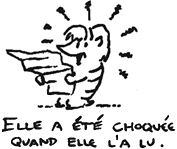Pronouns
Introduction to pronouns
A pronoun is a word used to replace a noun. It is commonly used to avoid repeating a previously mentioned noun known as the antecedent. In the following example, pronouns in bold face are used to replace the underlined antecedents.
| Tex a écrit un poème érotique, et puis il l‘a envoyé à Tammy. Elle a été choquée quand elle l‘a lu. | Tex wrote an erotic poem and then he sent it to Tammy. She was shocked when she read it. |

The different kinds of pronouns are named according to their grammatical function.
subject pronouns
| je, tu, il, elle, on, nous, vous, ils, elles |
I, you, he, she, one, we, you, they (m), they (f) |
 direct object pronouns
direct object pronouns
| me, te, le, la nous, vous, les |
me, you, him / it, her / it us, you, them (m) / (f) |
indirect object pronouns
| me, te, lui nous, vous, leur |
to me, to you, to him / her to us, to you, to them (m) / (f) |
the pronouns y and en
| y en |
there (replaces preposition + location) some, any, not any (replaces ‘de’ + noun) |
disjunctive pronouns
| moi, toi, lui, elle, soi nous, vous, eux, elles |
me, you, he, she, one we, you, them (m), them (f) |
reflexive pronouns
| me, te, se nous, vous, se |
myself, yourself, himself, herself ourselves, yourselves, themselves |
interrogative pronouns
| qui que |
who what |
demonstrative pronouns
| celui, celle ceux |
this one / that one (m,f) these, those |
relative pronouns
| qui, que lequel, laquelle |
who, whom, which which |
indefinite pronouns
| quelqu’un quelque chose |
someone something |

